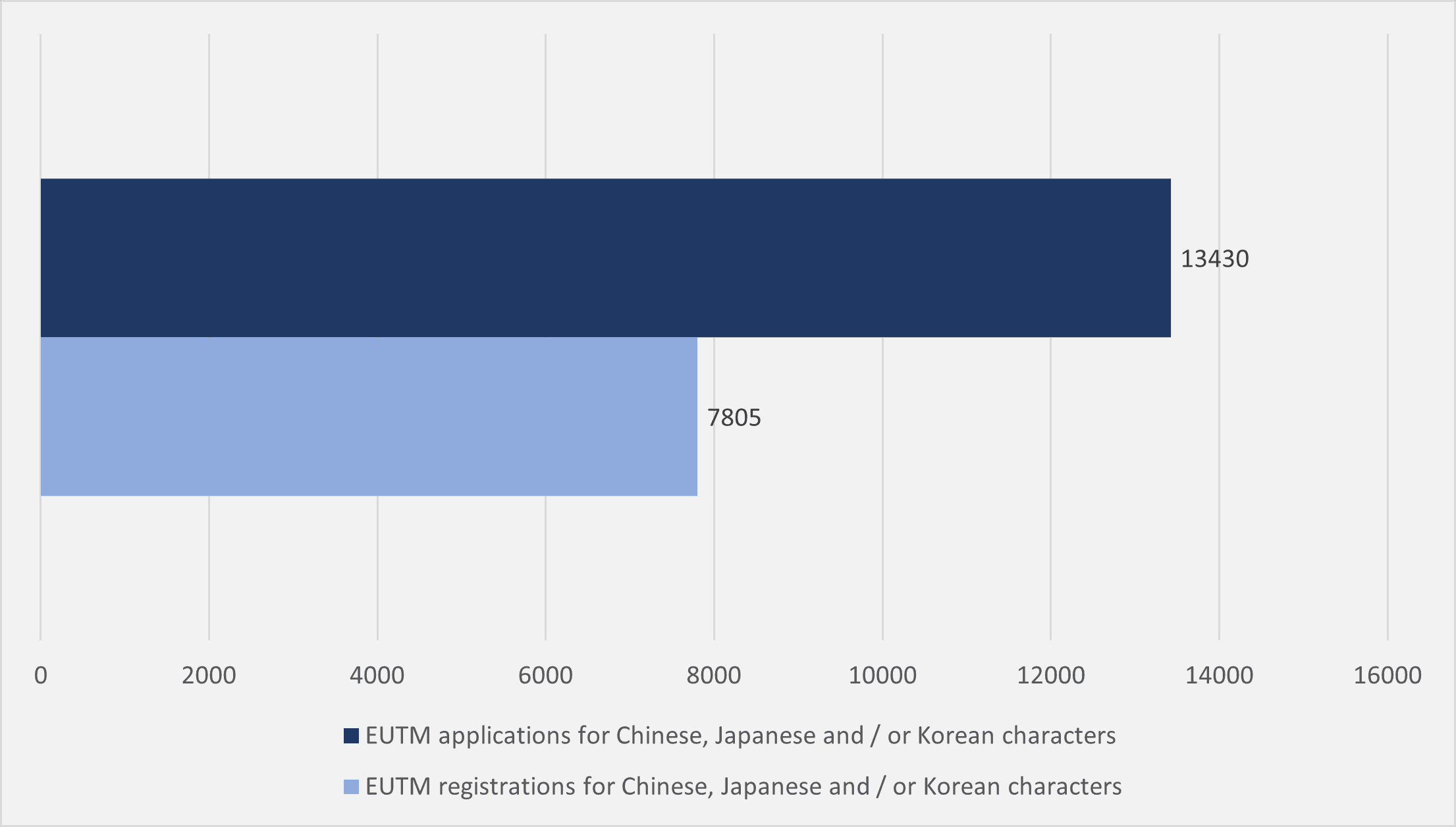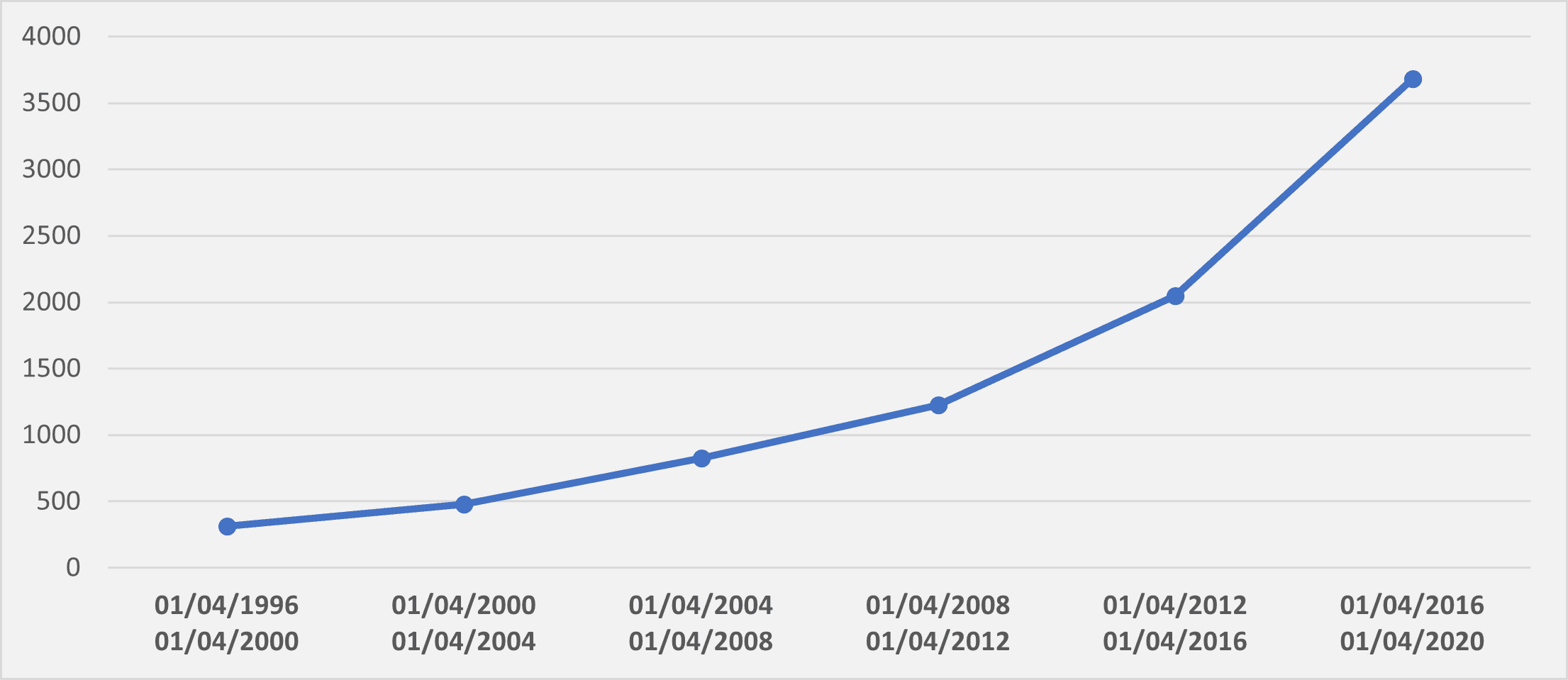
The Registration of Chinese, Korean and Japanese Characters as European Union Trademarks

According to the available information on the European Union Intellectual Property Office’s (EUIPO) database, since the 1st of April of 1996, 13.430 European Union trademark (EUTM) applications seeking protection for Chinese, Japanese and / or Korean characters were filed. Currently, resulting from those applications, there are 7.805 registered EUTM that consist of or include Chinese, Japanese and / or Korean characters.

Figure 1 - Comparison between the total number of EUTM applications for Chinese, Japanese and/or Korean characters and the total number of respective registrations.
The purpose of this article is to analyze how these characters are protected by EUTMs and the statistic evolution of EUTM applications covering them. The researcher for the information here presented was carried out using the EUIPO’s database and by application of the EUIPO’s modified Vienna Classification, namely, class 28.03 “Inscriptions in Chinese, Japanese or Korean Characters.
"Since Chinese, Japanese and / or Korean characters do not correspond to an alphabet of any official EU language they cannot be registered as word marks."
Types of EUTM
The EUIPO’s Trade mark guidelines presents the following mark types as available for protection: word, figurative, shape, position, pattern, colour, sound, motion, multimedia and hologram. Being registered as EUTM, Chinese, Japanese and / or Korean characters can only be of one of these types of mark.
In a first analysis, for they cannot consist of a character, it may be concluded that Chinese, Japanese and / or Korean characters cannot be registered as colour marks and sound marks. A colour mark is a mark consisting only of colour and a sound mark, despite being able to consist of a sound corresponding to a Chinese, Japanese and / or Korean character, cannot consist of the character itself.
Chinese, Japanese and / or Korean characters could be, in principal, protected as any other mark type, as they consist of words, they may be deemed as figures, they can be part of a shape of a product or its packaging, they may be positioned in a product in a certain way, if repeated they can form a pattern, they can be part of a motion, can be included in a mark with several types of mediums or can be or be part of a hologram.
How are Chinese, Japanese and / or Korean characters being registered as EUTMs?
But in reality, the distribution of the 13.430 EUTM applications for Chinese, Japanese and / or Korean characters, by the several mark types is as follows: 13.411 figurative marks, 13 shape marks, 2 colour marks and 4 “other” type marks.
As for the applications granted, Chinese, Japanese and / or Korean characters were registered as 7.794 figurative marks, 8 shape marks, 2 “other” type marks and 1 colour mark. It should be stressed that, the classification of this “colour” mark in EUIPO’s database is erroneous as it is actually a figurative mark.
Table 1 - EUTM applications for Chinese, Japanese and / or Korean characters by mark type
Table 2 - EUTM registrations for Chinese, Japanese and / or Korean characters by mark type
The first obvious conclusion is that almost all EUTM applications or registrations for these characters are figurative marks. Another clear fact is that no word mark could be found. Nor it could have been, as the Vienna Classification only applies to marks that include figures. However, the reason for not being possible to find any registered EUTMs for Chinese, Japanese and / or Korean characters as word marks is more meaningful.
Despite the EUIPO defining word marks as any “typewritten mark with elements including letters (either lower or upper case), words (either in lower or upper case letters), numerals or standard typographic characters.”, it can only be accepted if it is written in the alphabet of any official EU language. Since Chinese, Japanese and / or Korean characters do not correspond to an alphabet of any official EU language they cannot be registered as word marks.
Chinese, Japanese and / or Korean characters are not considered word elements by the EUIPO, but figurative elements. Therefore, its adequate mark type is the figurative mark or any other mark type which may include figurative elements.
" (...) the registration of a Chinese character corresponding to an English word already registered as a EUTM can be also registered as a EUTM, without infringing the prior rights"
The scope of protection and distinctiveness of Chinese, Japanese and / or Korean characters
The reason for all characters that do not correspond to an alphabet of any official EU language to be considered figurative elements instead of word elements is the premise that the relevant EU consumer does not understand those characters. If those characters are not understood they cannot function as word elements.
Therefore, its protection can only be visual. This means that phonetic and conceptual similarities with other trademarks are irrelevant. For example, the registration of a Chinese character corresponding to an English word already registered as a EUTM can be also registered as a EUTM, without infringing the prior rights.
Similarly, the distinctiveness of a Chinese character cannot be affected by its meaning. If the meaning of a Chinese character is not understood it cannot be taken into consideration when assessing its distinctive character. For example, if it is held that the relevant EU consumer does not understand the Chinese character for “water”, it will not be understood by the relevant consumer as an indication of the type of a good and, therefore, it can be registered in class 32, to cover water.
The evolution of Chinese, Japanese and / or Korean characters as EUTMs
However, this may change in the future, for example, if the number of Chinese speaking consumers in EU countries rises. The growing interest in having Chinese, Japanese and / or Korean characters registered as EUTMs is clear in the below graphic:

Figure 2 - Evolution of EUTM applications for Chinese, Japanese and/or Korean characters by filing date intervals
Conclusion
If the number of, for example, Chinese speaking consumers rises in the EU countries there may be a point where the premise that the relevant consumer does not understand Chinese characters will no longer be true. If this happens, Chinese characters will be held by the EUIPO as word elements and its meaning will become relevant when assessing its distinctive character and conceptual and phonetic similarity with previous EUTM registrations.
If this happens, an issue will rise. What will happen to the Chinese, Japanese and / or Korean characters already registered as EUTMs? Shall those Chinese, Japanese and / or Korean characters already registered as EUTMs, which meaning will then be understood as non-distinctive and those which will become phonetically and /or conceptually similar to previous EUTMs be subject to invalidation? Generally, the answer will have to be affirmative.
This article was originally published in China IP Magazine.





